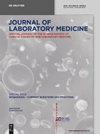总胆固醇、低密度脂蛋白胆固醇、高密度脂蛋白胆固醇和非高密度脂蛋白胆固醇的年龄和性别特异性参考区间。参考区间间接估计两种算法的比较
IF 1.1
4区 医学
Q4 MEDICAL LABORATORY TECHNOLOGY
引用次数: 0
摘要
【摘要】目的血浆中总胆固醇浓度及其组分低密度脂蛋白(LDL)、高密度脂蛋白(HDL)和非高密度脂蛋白浓度的参考区间与年龄和性别的相关性研究很少。因此,年龄和性别对参考区间的影响通过2个间接程序被重新调查。方法采用截断最小卡方法作为间接方法。所有分析均由可用的计算机程序完成。在德国临床化学和实验室医学学会(DGKL)的主页上发布的脚本允许导出参考区间的连续年龄依赖关系及其置信度和等效限制。将这种方法的结果与最近发展起来的一种间接方法,即refineR算法的结果进行了比较。结果在本研究中,总胆固醇的上限参考范围为5.1 - 7.8 mmol/L (197-302 mg/dL),这取决于各种生物学变量(如年龄、性别、住院患者与门诊患者)。这些上限随着年龄的增长而增加。除了80岁以上的年龄,性别差异可以忽略不计。低密度脂蛋白胆固醇和非高密度脂蛋白胆固醇的参考值与总胆固醇的参考值相似。女性高密度脂蛋白胆固醇的参考值高于男性,但与年龄无关。结论总胆固醇及其组分LDL-、hdl -和非hdl浓度的参考限值应按年龄和性别分层。本文章由计算机程序翻译,如有差异,请以英文原文为准。
Age-and sex-specific reference intervals of total cholesterol, LDL cholesterol, HDL cholesterol and non-HDL cholesterol. Comparison of two algorithms for the indirect estimation of reference intervals
Abstract Objectives Reference intervals of total cholesterol concentrations in plasma and of their fractions low-density lipoprotein (LDL)-, high-density lipoprotein (HDL)-and non-HDL concentrations are seldom studied with respect to the relevance of age and sex. Therefore, the effect of age and sex on the reference intervals was reinvestigated with 2 indirect procedures. Methods As an indirect approach, the truncated minimum chi-square method was applied. All analyses were performed by computer programs available. The script published on the homepage of the German Society of Clinical Chemistry and Laboratory Medicine (DGKL) allows to derive a continuous age dependency of reference intervals together with their confidence and equivalence limits. The results of this approach were compared with those obtained by an indirect method developed more recently, the refineR algorithm. Results In the present study, the upper reference limits of total cholesterol varied from 5.1 to 7.8 mmol/L (197–302 mg/dL) depending on various biological variables (as age, sex, inpatients versus outpatients). These upper limits increased with age. Differences between sexes can be neglected except for the age above 80 years. The pattern of reference limits of LDL cholesterol and non-HDL cholesterol paralleled those of total cholesterol. The reference limits of HDL cholesterol were higher in women than in men but were independent of age. Conclusions Reference limits for the concentrations of total cholesterol and their fractions LDL-, HDL-and non-HDL concentrations should be stratified for age and sex.
求助全文
通过发布文献求助,成功后即可免费获取论文全文。
去求助
来源期刊

Journal of Laboratory Medicine
Mathematics-Discrete Mathematics and Combinatorics
CiteScore
2.50
自引率
0.00%
发文量
39
审稿时长
10 weeks
期刊介绍:
The Journal of Laboratory Medicine (JLM) is a bi-monthly published journal that reports on the latest developments in laboratory medicine. Particular focus is placed on the diagnostic aspects of the clinical laboratory, although technical, regulatory, and educational topics are equally covered. The Journal specializes in the publication of high-standard, competent and timely review articles on clinical, methodological and pathogenic aspects of modern laboratory diagnostics. These reviews are critically reviewed by expert reviewers and JLM’s Associate Editors who are specialists in the various subdisciplines of laboratory medicine. In addition, JLM publishes original research articles, case reports, point/counterpoint articles and letters to the editor, all of which are peer reviewed by at least two experts in the field.
 求助内容:
求助内容: 应助结果提醒方式:
应助结果提醒方式:


